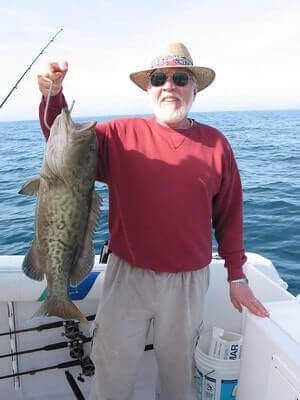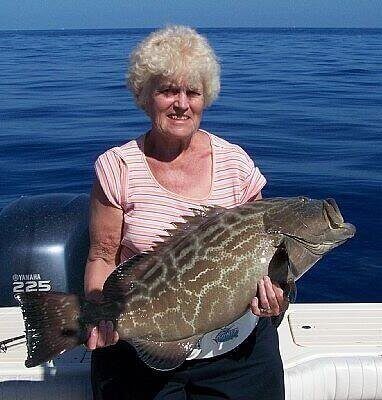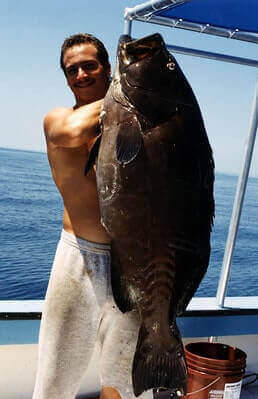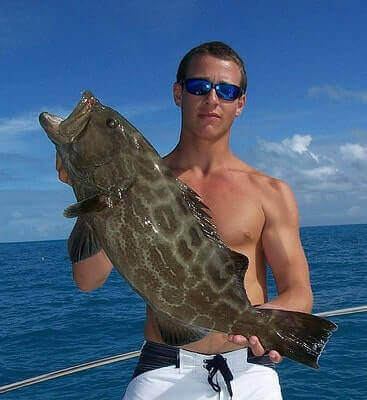Disclosure: We may earn commissions if you purchase products after clicking on a link from our site.
Are you looking for your next fishing challenge? Do you want to learn how to catch black grouper? Black grouper is a strong fish that will give you a fight when hooked. It has a habit of quickly moving to its hideout when hooked. This can easily cause your line to break. Black grouper can be found from North Carolina to Florida, to the Gulf of Mexico, and southern Brazil.
In this article, we will share information such as how to catch black grouper, the best bait and lures to use, as well as other information to help you catch this smart, big, and powerful fish.

Table of Contents
How To Catch Black Grouper
Black grouper (Mycteroperca bonaci) can be found around wrecks and reefs. They are big and powerful fish that can be found from North Carolina to Florida to the Gulf of Mexico, and Brazil. When hooked, the black grouper will fight hard and tends to quickly move to its hiding spot to free itself of the hook. Bottom fishing and drift fishing are some of the fishing methods used when fishing for black grouper.
1. Trolling
Trolling is another effective method for targeting black grouper, especially in deeper offshore waters. Anglers troll along the edges of reefs and drop-offs where black grouper are likely to be found. Using specialized trolling gear, such as downriggers or planer boards, anglers can present natural or artificial baits at various depths to entice black grouper strikes.
Common trolling baits include large diving plugs, skirted lures, or rigged ballyhoo. The key to successful trolling for black grouper is covering a wide area and varying trolling speeds and depths until fish are located. Once a strike occurs, anglers must quickly maneuver the boat to keep the fish away from underwater obstructions while fighting it to the surface. To learn more about trolling techniques, visit NOAA Fisheries.
2. Drift Fishing
Drift fishing is a versatile and effective method for catching black grouper, particularly in areas with strong currents or expansive reef systems. Anglers employ this technique by allowing their boat to drift naturally with the current while presenting baits or lures to black grouper along the way.
To catch black grouper using drift fishing, anglers typically use live baitfish, cut bait, or artificial lures such as jigs or swimbaits. By drifting over productive areas such as rocky ledges, drop-offs, or coral formations, anglers can cover a wide area and increase their chances of encountering black grouper.
It’s essential to adjust the weight of the rig according to the depth and current speed to maintain contact with the bottom while drifting. Additionally, anglers should be prepared to set the hook quickly when a bite is detected, as black grouper are known for their aggressive strikes.
Drift fishing allows anglers to explore different parts of the water column and adapt to changing conditions, making it a popular choice among anglers targeting black grouper. For more information on how to catch black grouper using drift fishing, visit NOAA Fisheries.
3. Bottom Fishing
Bottom fishing is a popular method used to catch black grouper. Anglers typically anchor their boats over rocky ledges, reefs, or wrecks where black grouper are known to inhabit. Using heavy-duty fishing rods and reels equipped with braided lines, anglers lower baited hooks to the bottom and wait for black grouper to take the bait.
Common bait options include live fish, squid, or cut bait. Once a bite is detected, anglers must quickly set the hook and carefully reel in the fish to avoid it retreating into its rocky habitat. This method requires patience and skill, as black grouper are known for their strength and tendency to seek refuge in underwater structures. For more information on bottom fishing techniques, visit NOAA Fisheries.
4. Jigging
Jigging is a dynamic fishing method that can be highly effective for catching black grouper, especially around underwater structures such as reefs and wrecks. Anglers use heavy jigging rods and reels loaded with braided lines to drop heavy metal jigs to the bottom.
By rapidly lifting and dropping the jig in a vertical motion, anglers can mimic the movement of injured baitfish, which can trigger aggressive strikes from black grouper. Successful jigging for black grouper requires precise boat positioning and control to keep the jig within the strike zone while avoiding snags on the bottom.
Anglers must also be prepared for powerful strikes and fast-paced battles when hooked up with a black grouper. For more information on jigging techniques, visit NOAA Fisheries.

Best Baits For Black Grouper
- Pilchards
Pilchards, also known as scaled sardines, are highly effective bait for black grouper fishing. These small, silvery fish are abundant in coastal waters and make a natural prey for predatory species like black grouper. Anglers targeting black grouper often use live or fresh-dead pilchards rigged on a hook or fishing line to entice strikes.
The oily and fragrant nature of pilchards attracts black grouper from a distance, making them an irresistible meal. When using pilchards as bait for black grouper, anglers typically present them near structures such as reefs, wrecks, or rocky outcrops, where black grouper are known to inhabit.
Slowly drifting or anchoring near these areas and deploying pilchards at different depths can increase the chances of attracting black grouper. It’s essential to use appropriate tackle and rigging techniques to ensure the pilchard remains securely attached to the hook and can withstand the powerful strikes of black grouper. With their proven effectiveness and availability in many coastal regions, pilchards are a favored bait among anglers pursuing black grouper.
2. Pinfish
Pinfish are a popular bait choice among anglers targeting black grouper due to their availability and effectiveness in enticing strikes. These small, silver-colored fish are found in abundance around reefs, wrecks, and other structures where black grouper reside.
Anglers typically catch pinfish using small hooks baited with shrimp or squid near the structure where black grouper are known to frequent. Once caught, pinfish can be rigged on a hook and deployed at various depths to attract black grouper.
Their natural swimming action and scent make them irresistible to black grouper, prompting strikes even from wary fish. When using pinfish as bait for black grouper, anglers often employ live or fresh-dead presentations, allowing the pinfish to swim freely and appear as natural prey.
Proper rigging techniques and sturdy tackle are essential to ensure the pinfish remains securely attached to the hook and can withstand the powerful strikes of black grouper. Overall, pinfish are a reliable bait choice for anglers seeking to catch black grouper in their habitat.
3. Threadfin
Threadfin are highly effective baitfish for targeting black grouper, known for their slender bodies and distinctive thread-like extensions on their dorsal and anal fins. To catch black grouper using threadfin as bait, anglers often utilize sabiki rigs or small hooks baited with shrimp or cut bait near structures such as reefs, wrecks, and ledges where black grouper are commonly found.
Threadfin can be caught inshore or offshore, depending on the location of the fishing grounds. Once secured, threadfin can be rigged whole or cut into chunks and deployed at various depths to entice strikes from black grouper. Their natural swimming action and scent make them enticing prey for black grouper, prompting aggressive strikes.
Anglers often deploy threadfin using live or fresh-dead presentations, allowing them to swim freely and appear as natural prey. Proper rigging techniques and sturdy tackle are crucial to ensure the threadfin remains securely attached to the hook and can withstand the powerful strikes of black grouper. Overall, threadfin is a sought-after bait choice for anglers targeting black grouper, offering an excellent chance of success when presented effectively.
4. Crabs
Crabs are a favored bait for catching black grouper due to their natural abundance and enticing scent. Anglers typically catch crabs using crab traps, baited with fish carcasses or other bait materials, placed in strategic locations such as channels, nearshore reefs, or rocky bottoms where black grouper are known to frequent.
Once captured, crabs can be rigged onto hooks using various methods, such as through the back or claws, to ensure they remain secure during presentation. Live or freshly caught crabs are preferred, as they emit natural movements and scents that attract black grouper.
Anglers often employ heavy tackle and sturdy hooks to handle the powerful strikes of black grouper when using crabs as bait. Proper presentation and placement of the crab bait near structures or ledges where black grouper hide are essential for success.
Additionally, anglers may opt to use crab-like artificial lures designed to mimic the appearance and movements of real crabs, providing an alternative option when live bait is unavailable. Overall, crabs serve as a highly effective bait choice for anglers targeting black grouper, offering a natural and irresistible meal for these voracious predators.
5. Squid
Squid is a popular bait choice for black grouper fishing, known for its strong scent and durability. Anglers often catch squid using specialized squid jigs or by deploying squid traps baited with fish scraps to attract them. Squid can also be purchased frozen from bait shops for convenience.
When rigging squid as bait for black grouper, anglers typically cut the squid into strips or chunks and thread them onto large, sturdy hooks using a bait needle or rigging needle. Properly rigged squid can withstand the strong strikes of black grouper and remain on the hook during the fight.
Anglers may also opt to use whole squid, especially when targeting larger black grouper species. Presentation is key when using squid as bait for black grouper, and anglers often fish near rocky ledges, reefs, or wrecks where black grouper are known to congregate. The squid’s natural scent and movement in the water entice black grouper to strike, making it a highly effective bait option.
Anglers should use heavy tackle and strong leaders to handle the powerful fighting abilities of black grouper when using squid as bait. Overall, squid is a versatile and reliable bait choice that can help anglers successfully target black grouper in various fishing conditions.
6. Goggle Eyes
Google Eyes, also known as blue runner, is a popular live bait option for black grouper fishing due to their availability and effectiveness. These baitfish can be caught using a variety of methods such as casting with small jigs or lures, trolling with diving plugs, or using baitfish traps.
When targeting black grouper, anglers typically rig live Google Eyes on heavy-duty circle hooks with a wire leader to prevent break-offs from the grouper’s sharp teeth. The baitfish is usually hooked through the nose or just above the dorsal fin to ensure natural presentation and movement in the water.
Anglers often fish live Google Eyes near reefs, wrecks, or other underwater structures where black grouper are known to inhabit. The live-action and natural scent of Google Eyes make them irresistible to black grouper, enticing strikes and resulting in successful catches.
However, anglers should exercise caution when handling Google Eyes, as they have sharp spines and can be difficult to control. Overall, using live Google Eyes as bait for black grouper fishing can significantly increase the chances of hooking into these prized game fish.
7. Cigar Minnows
Cigar minnows are a favored bait choice among anglers targeting black grouper due to their resilience and attractiveness to these predatory fish. To catch cigar minnows for black grouper fishing, anglers often employ live bait rigs or sabiki rigs baited with small pieces of cut bait or shrimp.
These rigs are typically fished near offshore structures such as reefs, ledges, and wrecks where cigar minnows congregate in large numbers. Once caught, cigar minnows are rigged on heavy-duty circle hooks using wire leaders to prevent break-offs from the grouper’s sharp teeth.
Anglers commonly hook the cigar minnows through the nose or behind the dorsal fin to allow for natural swimming action in the water. When presented properly, cigar minnows emit enticing vibrations and scents that attract black grouper, leading to aggressive strikes.
Fishing with cigar minnows near underwater structures known to harbor black grouper populations can yield productive results, making them a valuable bait option for anglers pursuing these prized game fish.

Best Lures For Black Grouper
- Jigs
Jigs are highly effective lures for catching black grouper, offering versatility and enticing action to attract these formidable fish. Anglers targeting black grouper often employ heavy-duty jigs equipped with strong hooks and durable skirts or soft plastic bodies. These lures mimic the movement of natural prey, such as small fish and crustaceans, enticing black grouper to strike.
To catch black grouper using jigs, anglers typically fish them near the seafloor around rocky outcrops, ledges, and reef structures where grouper tend to congregate. Anglers employ a variety of jigging techniques, including vertical jigging and casting-and-retrieving, to entice strikes from black grouper.
Vertical jigging involves dropping the jig to the bottom and then rapidly jerking it upward through the water column to mimic the erratic movements of fleeing prey. Alternatively, anglers may cast jigs near underwater structures and employ a slow, steady retrieve to mimic the natural swimming action of injured baitfish.
By varying the jig’s depth, speed, and action, anglers can effectively target black grouper in a range of conditions and environments. Jigs come in a variety of colors, sizes, and weights, allowing anglers to tailor their presentation to match the prevailing conditions and preferences of the black grouper. With their proven effectiveness and adaptability, jigs are a popular choice among anglers seeking to catch black grouper in both shallow and deepwater habitats.
2. Plugs
Plugs are excellent lures for enticing black grouper, offering a realistic appearance and enticing action that can trigger aggressive strikes. These lures typically mimic the appearance and swimming behavior of injured baitfish, making them highly effective at attracting predatory species like black grouper.
Anglers targeting black grouper often use diving plugs equipped with strong hooks and durable construction to withstand the powerful strikes and rugged underwater terrain where these fish are found. To catch black grouper using plugs, anglers typically fish them near submerged structures such as rocky ledges, reef edges, and underwater pinnacles where grouper tend to congregate.
By casting plugs into these areas and retrieving them with a steady, rhythmic motion, anglers can mimic the natural swimming action of injured baitfish, enticing black grouper to strike. It’s essential to vary the retrieve speed and depth to determine the most effective presentation for the prevailing conditions and the behavior of the fish.
Additionally, anglers may choose plugs in a variety of colors and sizes to match the local forage and water clarity. With their lifelike appearance and enticing action, plugs are a valuable addition to any angler’s arsenal when targeting black grouper in both shallow and deepwater environments.
Black Grouper Fishing Setup
Black grouper is a big, powerful, and tenacious fish. When hooked, it will put up a spirited fight that you may be surprised by. It tends to run to cover when hooked to free itself. This can also break the line.
Heavy-duty tackle is needed to be successful when fishing for black grouper. An 80-pound braided line with a 100-pound leader will work. Heavy jigging tackle improves your chances of getting black grouper from their hideouts. Additionally, use a reel that is capable of at least 20 pounds of drag.
Black Grouper Fishing Tips
- Black grouper can be found near wrecks, ledges, rocky bottoms, crevices, bays, jetties, shoals, and reefs.
2. Black grouper will be on the up-current side of a wreck. Don’t position your boat directly over a wreck and try to get a black grouper out of the wreck; it won’t happen. Anchor way up-current and let out adequate line to get close.
3. In the United States, black grouper can be found from the Gulf of Mexico to Florida and up to North Carolina.
4. Black grouper will put up a long and hard fight when hooked.
5. Drift fishing, still fishing, chumming, bottom bouncing, and saltwater jigging are some of the fishing methods used when fishing for black grouper.

6. Live bait is the best bait to use when fishing for black grouper, although dead bait also works.
7. Trolling deep diving plugs and ballyhoo are very effective in catching black grouper.
8. Always keep the bait just above the bottom when fishing for black grouper.
9. Black grouper spawns during the winter months.
10. Black grouper are not blessed with speed.
11. Sharks and moray eels are predators of black grouper. If you are reeling in a black grouper and suddenly see sharks or moray eels, just be aware that they are after the black grouper. Be prepared to battle with them also for your catch.

The Bottom Line
Black grouper is a favorite game fish for anglers. It is large, powerful, and puts up a hard fight. When hooked black grouper runs to its hideout to free itself of the hook. They are found near structures like wrecks, ledges, rocky bottoms, crevices, bays, jetties, shoals, and reefs.
In this article, we discussed how to catch black grouper, the fishing setup, the best baits and lures to use as well as shared fishing tips to help you catch this delicious gamefish. You can also read how to catch grouper, how to catch gag grouper, how to catch rock hind, how to catch alligator gar, how to catch tilefish, and how to catch triggerfish.